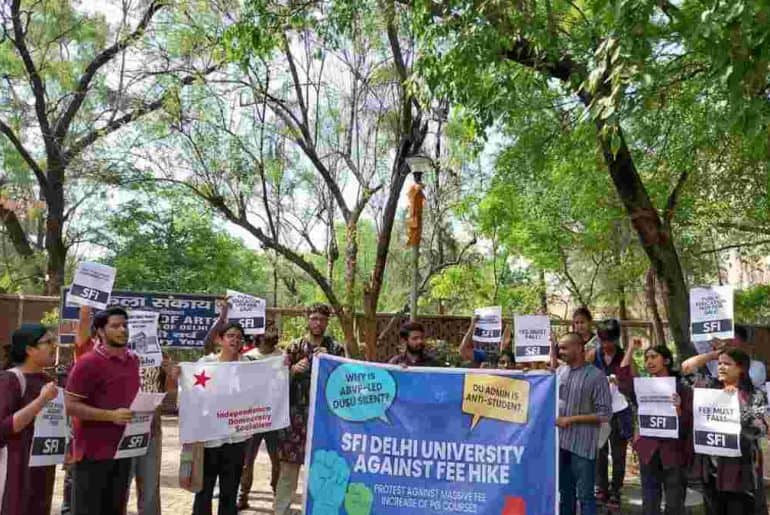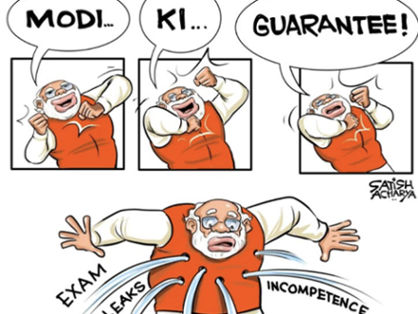In the aftermath of the Lok Sabha Elections, the nation stands shook by the NEET and UGC-NET paper leaks. Besides, privatisation of public education and saffronisation of the curriculum were major issues that were raised recurrently throughout the decade. While the present diaspora signals towards a supposedly balanced Lok Sabha with the Opposition winning close to majority seats, is there any positive hope for the future of public education in India?
June 4, 2024, allegedly invited a new ray of hope for Indian democracy. Netizens chanted, ‘Democracy is back!’, the opposition rejoiced with a near majority, and a sliver ray of hope was projected for the upcoming 5 years. Studio-pandits dominated television screens with their expertise upon a more balanced parliamentary representation- with the INDIA Alliance thundering at nearly 230 seats, and the Congress owning 99 of them. ‘A balanced Parliament will keep the Modi Goliath in check’, was the unanimous declaration. ‘Economic measures will be balanced out further with GST in check!’, ‘Hindutva politics will be in check!’, ‘The Constitution is safe and it will be hard to pass the UCC (Uniform Civil Code) with a strong opposition!’, Twitteratis declared.
However, through all the discussions about the potential action-plan of ‘Modi 3.0’, there was one particular sector that was left out- Public Education, the same ministry that is now facing major hit-backs 15 days into ‘Modi 3.0’.
On June 24, as the 18th Lok Sabha launched its functioning, Opposition ministers were witnessed to chant ‘NEET! Shame!’ as the Education Minister, Dharmendra Pradhan, walked towards the podium to undertake his oath for the newly-formed Government. While student protests asking for ‘RE-NEET’ and a CBI probe into the paper leak overtook the streets of New Delhi and across India, the future of 24 lakh medical aspirants lies uncertain in the hands of a government averse to the concerns of national education previously.
When it comes to the Modi report card in terms of public education in India, the sector has undergone significant tinkering in terms of rewriting NCERT textbooks and introduction of the National Education Policy 2020; the government has failed to look into the administrative and managerial failures to implement such measures and policies within most government-run schools. With rising summer temperatures across the subcontinent and the atrocity of climate change, the education sector is on the verge of suffering yet another setback- potential dropouts and absenteeism by students due to lack of air-conditioning or functional fans in government-run schools and colleges giving rise to miserable environments which are not conducive for learning. An instance worth mentioning is the May-term examinations conducted by Delhi University amidst scorching 50 degrees Celsius.
When it comes to investment in public education, the government’s ambitious National Education Policy promised a whopping 6% of GDP by 2020. However, as per a report by Scroll.in, expenditure pertaining to education counts at 2.8% of GDP in 2019-20, and a marginal increase to 3.1% in 2022. Contrastingly, the BJP’s 2014 manifesto claimed that, “investment in education yields the best dividend.” However, the ruling party’s words have hardly aligned with their actions. Another report by Scroll.in draws upon the comparison that between 2004-24, the Congress-led Union Government invested nearly 0.61% of the GDP annually towards education. On the other hand, between 2014-24, the number significantly reduced to 0.44% of the GDP annually.
Simultaneously, the National Education Policy of 2020, introduced by the Modi government has also faced several criticisms. Several critics, student activists from the left-bloc and academicians claim that NEP has fuelled the privatisation of public education through exorbitant fee hikes, which makes it less inclusive for the economically-marginalized. Numerous exit options open doors for candidates to drop out of college much more easily. While NEP aims towards digital enhancement of classrooms- several academic institutions in India lack basic infrastructure to implement the same- several schools and colleges even lack facilities like proper hygienic washrooms and water-filters.
Under the guise of “syllabus rationalisation”, the country has witnessed its school textbooks being rewritten, its history reshaped to give birth to a ‘monocultural narrative’ at the expense of India’s multiculturalism. While school textbooks are crucial for the construction of a ‘civilizational memory’, underfunding and budget cuts in public schools hamper the development of human capital and the long-term growth of the nation.
Since 2017, the NCERT has undergone significant changes in its curriculum, all of which were passed against a weak-opposition in the House. Several instances such as the exclusion of the Mughal era from Class 12 history textbooks, removal of texts on the caste system, social movements, brief ban of the RSS post-independence and Gandhi’s unpopularity with Hindu extremists, were observed in 2022. Furthermore, in 2023, Charles Darwin’s Theory of Evolution was excluded from the curriculum as well.
Post the Lok Sabha election of 2024, the NCERT took another move towards removing any mentions of the Babri Masjid and swapped it with the phrase, “three-domed structure”. Such omissions in the curriculum were justified with fervour by BJP MPs later.
In 2022, BJP leader, Kapil Mishra explained the exclusion of the Mughal era from the syllabus alleging that “thieves” were referred to as the “Mughal rulers” and this initiative of reshaping the curriculum will “shine light on the truth.” Similarly, on being questioned about the removal of the mention of the Babri Masjid from textbooks, NCERT Director, Dinesh Prasad opines that, “teaching about riots in school textbooks can create violent, depressed citizens.” On the other hand, several critics and netizens claim that reshaping historical narratives is a convenient way to “whitewash the Ayodhya dispute.” However, it is not difficult to point out that the changes undergone by the NCERT in recent years reflect a strong saffronized stance- an alleged BJP-led government move to eliminate text that challenges the Hindutva worldview.
While curriculum-reshaping and a lack of basic infrastructure hamper public schools in the country, the BJP manifesto had promised to bridge the digital divide persisting within the country. The online-education era propelled by the COVID-19 pandemic showed that students had scant access to digital devices and the internet. Moreover, the pandemic-era led to major learning losses that are yet to be addressed.
The Modi government has not fared well through the decade when it comes to funding higher-education institutions as well. The Government changed the mode of financing from grants to loans for such institutions, which consequently caused central institutions struggle to repay loans and in turn pressurise their administration to increase fees or compromise upon other aspects of education. The BJP-majority government also rolled out a scheme to identify 50 ‘Institutes of Eminence’ by 2019 and develop them into world-class universities. However, the said-scheme has slobbered and only 20 institutions have been identified till now.
When it comes to affirmative action, the government introduced a 10% reservation for economically-backward classes and directed public institutions to increase their seats for the same. However, several institutions lacked classroom infrastructure to intake students above the usual capacity. Casteism runs rampant to this day on academic campuses. In December 2023, the Education Minister replied to a question in the Lok Sabha that, “In the preceding five years, 2622 STs, 2424 SCs, and 4596 OBC students dropped out of central universities.” This paints an ugly picture of the caste discrimination that bleeds through the country even today.
Moreover, in another attack on minorities, the government withdrew the Maulana Azad Fellowship for Muslim students and even excluded students from humanities background from the National Overseas Scholarship intended for students from marginalized backgrounds.
Besides, the education domain from 2014-24 witnessed the maximum number of student protests- with student political parties and youth wings like AISA, SFI, and NSUI holding rallies and marches against the Gaza War, Saffronisation, NEP, fee hikes, and hostel infrastructure for women, to ABVP joining protests related to the NEET 2024 paper leak.
Out of the endless issues that have been raised with the Modi Government’s decade of “revamping Indian education,” the most pertinent of these remains the display of religiosity in otherwise secular campus spaces. From the Hijab ban that proved to be a litmus test for democratic secular values to the Ayodhya Consecration ceremony that was widely celebrated with ‘hawans’ and ‘bhandaras’ across academic institutions, there have been monocultural biases when it comes to regulations upon displays of religiosity within learning spaces. This needs the state to create a healthy balance between the sanctity of secular educational spaces and the individual right to religious expression. However, with the widespread saffronisation of education across the country, rewriting textbooks and faculty displacements, the BJP’s attack on public education reflects an ethno-cultural majoritarian election agenda.
Moreover, several attempts have been made to document mass-faculty displacements in public colleges, with highly-qualified teachers being fired despite years of experience due to ideological and other pertinent differences; the faculty displacement within the Sociology department of IPCW in 2023 and Ramjas’ English Department in the same year are noteworthy instances. This has led to widespread agitation amongst students who were afraid to speak out amidst stringent suppressive measures taken by the administration of the respective colleges.
While the administrative, managerial and intellectual architecture of the Indian education system is being rapidly eroded by aggressive saffron policies, one can only hope that a healthy Opposition granted by the 18th Lok Sabha elections can voice the concerns of the students. Meanwhile, the NEET-fiasco has dug out the deeply disturbed state of testing agencies and the ignorance of the education ministry to preserve the sanctity of public education.
In such circumstances, one can only hope student protests aren’t curbed, the sanctity of investigation bureaus is maintained and opposing voices are respected within the state as a crucial part of the democratic mechanism rather than being equated with the ‘anti-national’ tag. India’s public education system is a ticking time-bomb. It is only a matter of time before it explodes and rubs out the sanctity of what we call India itself.
Read Also: Faculty Displacement at IPCW: Impact on Students and Academic Integrity
Featured Image Credits: Cartoonist Satish Acharya
Priyanka Mukherjee
[email protected]










